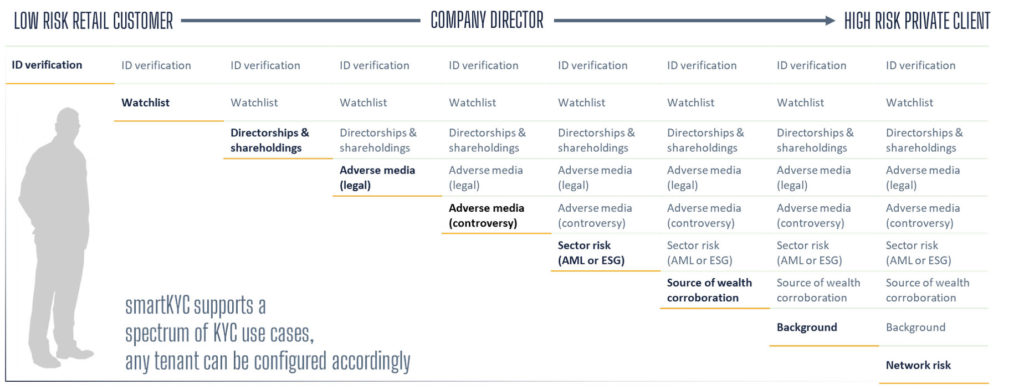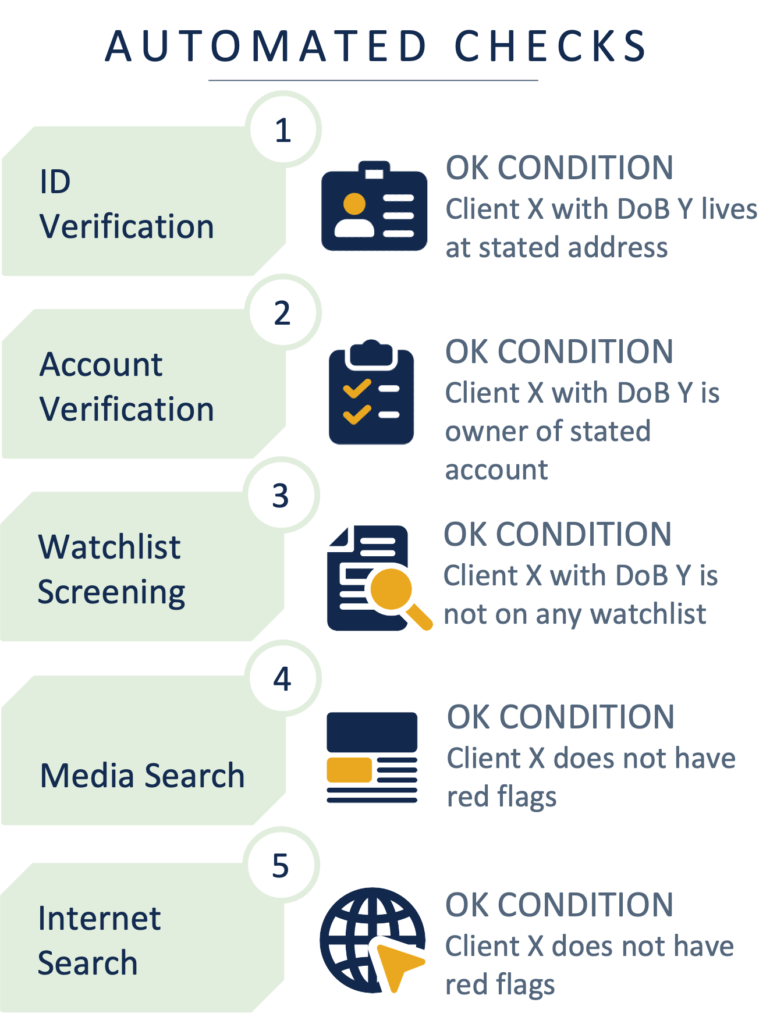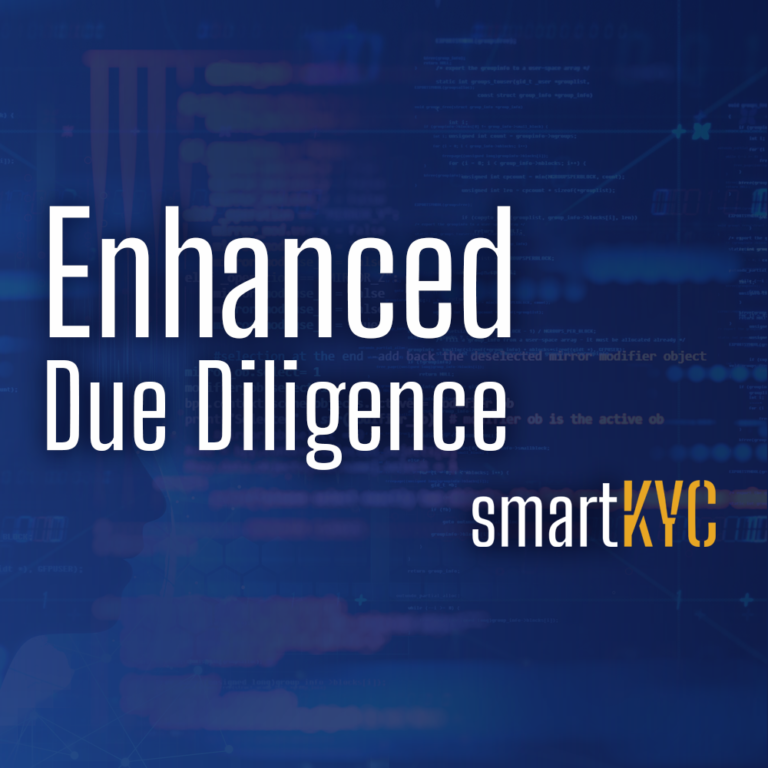When to use Enhanced Due Diligence
Know Your Customer (KYC) screening can take many forms as a process and certainly as a technology solution in our ever expanding industry. At a minimum, companies have a requirement to check and verify an individual’s identity by using document verification and/or biometric tools, which may suffice in terms of a full KYC check on clients where the risk is either deemed low or the funds in question are below the amount where a heightened form of due diligence is required by the regulator.
It is when clients could be deemed higher risk or they are depositing larger amounts of money where some form of Enhanced Due Diligence (EDD) is required and background checks on other sources, in addition to identity verification, is mandatory.

Confirming that a person is who they say they are is one thing but determining if that individual is someone you wish to do business with is another; this opens up a whole myriad of potential red flags a company may wish to investigate.
Historically, and still in many current instances, EDD was exclusively a manual process using human intelligence, but with the advent of real world uses of artificial intelligence and other innovative technologies, more and more firms are using tools to automate their EDD processes as much as possible.
Why smartKYC uses Multilingual Natural Language Processing, not just NLP
At smartKYC we use specific fields of artificial intelligence to automate EDD screening, the main one being natural language processing (NLP), or uniquely in our case: multilingual natural language processing (MNLP).
NLP takes many forms, but essentially, it allows for computational programs to understand the language of a document as well as contextual nuances. It also has the ability to extract exact information and provide key insights. NLP technology can process and analyse vast amounts of data that would otherwise either be impossible, or incredibly labour and time-intensive to do.
MNLP is imperative in automating EDD screening when it comes to unstructured sources such as online news and web results. Our emphasis on the multilingual part to the private banks and wealth managers we work with, is that it is somewhat risky to assume negative news may have been written about their client or prospective client in the English language and Latin script alone.
For instance, a private bank may wish to onboard an ultra high net worth client from Indonesia and some form of EDD is required due to the amount of funds in question. It would be foolish to assume such an individual may only have press written about them in a UK national newswire in English. A more specific form of EDD should be required and searching in Indonesian newswires in the Bahasa language, as well as globally recognised publications, would be more suited and thorough. This is indeed the methodology human intelligence units have used for EDD, so why not apply the same principles to technology?
The Importance of Using true Multilingual Natural Language Processing (MNLP)
A nuance with MNLP, albeit an important one, is to apply true MNLP and not to translate a document into English first and then run an English NLP algorithm at that point. This is an approach where you will lose a lot of the ‘natural language’.
Every language has its own structure and syntax, with each one needing a high degree of understanding by MNLP solutions in order to properly process and contextualize the documents they are machine reading. Just translating words alone does not give a machine, nor indeed a human, any real context and some words even have dual or opposite meanings.
For example, a very topical word right now is ‘sanction’, but it can have the opposite meaning or intent depending on how it’s used. The two statements: ‘Vladimir Putin has been put on a sanctions list’ and ‘Vladimir Putin has been sanctioned for his role in the war’ are two variations of the same word, one a noun, the other a verb, but they both have negative connotations and would raise red flags in many negative news screening tools. However, the same word used as a verb again can also have the opposite meaning as to allow or permit something: ‘The scheme was sanctioned by the government’.
This is just one example in the English language. They are omnipresent in all the various forms of unstructured data in open source intelligence (OSINT), in all their respective languages and alphabets.
Automated EDD in Practice – A Robo Onboarding Case Study
- A large wealth manager wished to create a fully automated and paperless onboarding process for mass affluent clients on their new robo-advisor platform.
- The minimum amount of deposited funds from clients was £15,000 and therefore some form of automated EDD was required.
- smartKYC created a fully automated 5 step process to achieve this by connecting with a well known credit agency for ID and bank account verification, the wealth manager’s own internal sources and lists, and external open sources.
- If all steps were passed – ID and Bank account verified, no red flags found on watchlists and no adverse media – then the client was approved an account automatically with no human interaction.
- The whole onboarding process took between 3 and 5 minutes and was seamless to the client signing up to the robo-advisor, as the background checks occurred whilst they were filling out an investment preference questionnaire.

AI Does Not Replace Humans (Not Entirely…)
When considering any AI application it is important to remember that AI is not here to completely replace human labour or not yet, anyway. AI applications can be incredibly powerful and useful for taking away a lot of manual labour, leaving humans to focus on the tasks that really matter.
It is no different when it comes to Enhanced Due Diligence. The bulk of the workload can now be completed using AI, in this case the searching, processing and filtering of results, leaving an EDD analyst to focus only on found potential red flags found.
About smartKYC
smartKYC is the world’s most advanced enterprise solution for due diligence automation. Comprising a diverse team of experts in the field of open source intelligence technology, smartKYC marries technical excellence with pioneering market expertise.
Recently, smartKYC’s contribution to the due diligence industry has been getting them noticed and they have garnered awards across several disciplines, including technology, AI and ESG. Just last month, they won two prestigious awards. First, they won ‘Best Know Your Customer Solution’ in RegTech Insight Awards 2022, and secondly they won in the Computing Awards for the third year in a row, this time in the category of ‘Explainable AI.’
If you’re interested in learning more about smartKYC’s award-winning technology and how it can transform the efficiency and effectiveness of your KYC operations, book your demo today.

